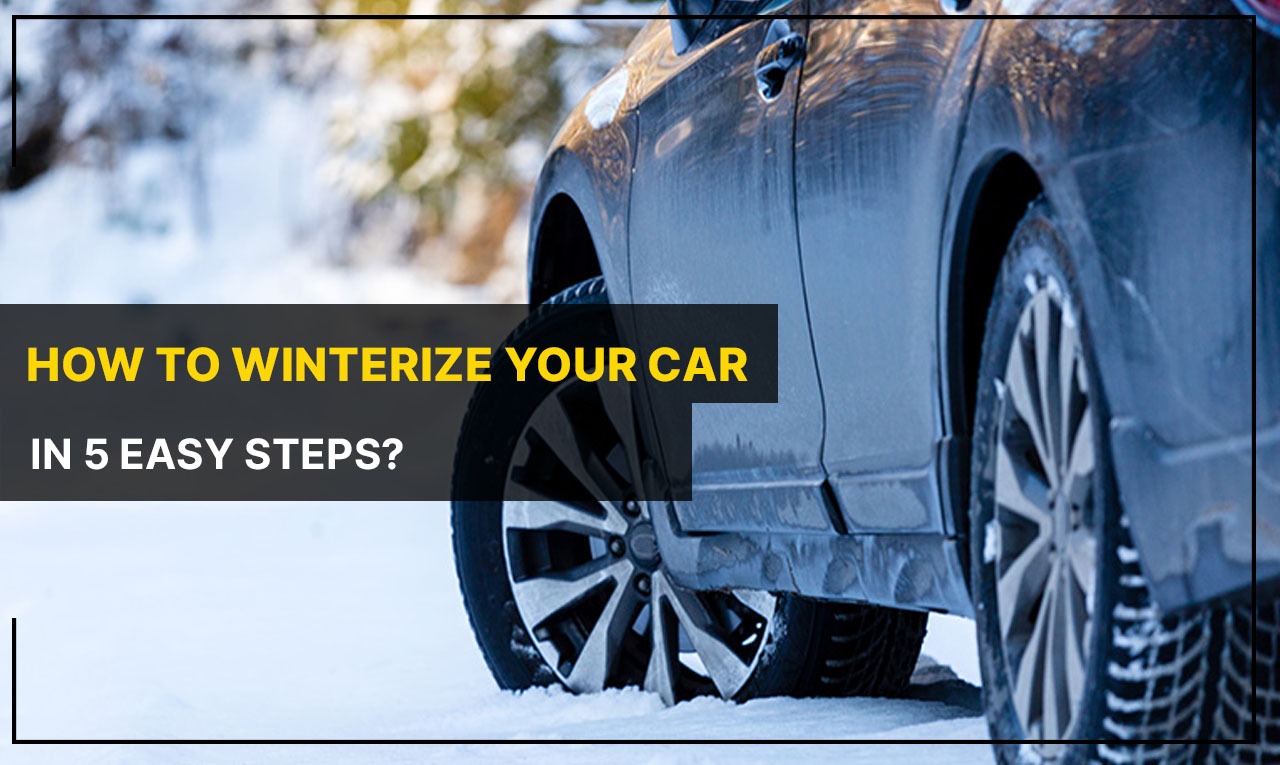
As winter approaches, preparing your car for the challenges that cold weather can bring is essential. Therefore, how to winterize your car appears as the most prominent question. Winterizing your vehicle ensures your safety on the road and helps prevent potential damage and breakdowns. These instructions will steer you through the steps to winterize your car, keeping it running smoothly during the coldest months of the year.
This blog contains:
- Why Winterizing Your Car Is Important
- Tips For Winterizing Your Car
- Some Additional Tips On Driving In Winter
Why Winterizing Your Car Is Important
Winterizing your car is a proactive and practical approach to safeguarding your investment and well-being. The frigid temperatures, icy roads, and reduced visibility often accompany winter can pose unique challenges for your vehicle. By knowing how to winterize your car and preparing your car for the winter season, you not only enhance its performance but also contribute to a more enjoyable and stress-free driving experience. This comprehensive guide will delve into specific tasks and tips to fortify your car against the winter elements, ensuring you're well-prepared for whatever the colder months may bring. From the battery to the tyres and everything in between, let's embark on the journey to winterize your car and make the upcoming season a safer and more comfortable driving experience.
Tips For Winterizing Your Car
We must now delve into a deeper study of how to prepare your car for the winter. So, without further ado, let us enter into this journey together, tailoring our approach to ensure that your car is not just winter-ready but also customised for your driving habits and local climate.
Check Your Battery:
The cold weather can significantly affect your car's battery performance. Begin by inspecting the battery for any signs of corrosion on the terminals. Clean them using a battery cleaning brush and a mixture of baking soda and water. Additionally, check the battery's charge level; if it's low, consider charging it or replacing it if necessary.
Inspect the Antifreeze/Coolant:
Ensure your car's coolant is a 50/50 mix of antifreeze and water. This mixture prevents the coolant from freezing and causing damage to your engine. Check the coolant level and top it off if needed. Consider having a professional, like Astute Automotive, perform a coolant flush which will help to keep your car warm in the winter if it has yet to be done recently.
Examine Your Tyres:
Your tyres are crucial for maintaining traction on icy or snow-covered roads. Check the tyre pressure regularly, as it tends to drop in colder temperatures. Ensure the tyres have sufficient tread depth to handle winter conditions. Consider switching to winter tyres for enhanced performance in snow and ice.
Replace Worn Wiper Blades and Refill Washer Fluid:
Visibility is critical during winter driving, how to winterize your car becomes all the more important to understand. Replace worn-out wiper blades and ensure your windshield washer fluid is filled with a winter-grade solution that won't freeze. Consider carrying an extra bottle of washer fluid in your trunk for emergencies.
Test Your Lights:
Days are shorter during winter, so ensuring all your lights are working correctly is crucial. Verify your headlights, brake lights, turn signals, and hazards. Replace any burnt bulbs, and consider cleaning the lenses for optimal visibility.
Inspect the Exhaust System:
A leaky exhaust system can be hazardous during winter when you're likely to keep your windows closed. Check for any rust or holes in the exhaust system, and have it repaired if necessary.
Keep Your Fuel Tank Full:
A full tank of gas helps prevent your fuel line from freezing and provides a safety buffer in case you get stranded in cold weather and is undeniable factor in how to winterize your car. During winter, try to keep your tank at least half full.
Prepare an Emergency Kit:
In case of an unexpected breakdown or getting stuck in the snow, having an emergency kit in your car is wise. This kit should comprise a blanket, extra warm clothing, non-perishable snacks, a flashlight, a first aid kit, and a shovel.
Check Your 4WD System (if applicable):
If your vehicle has a four-wheel-drive (4WD) system, ensure it's in good working condition. Test it before the winter season begins to ensure it engages and disengages smoothly.
Some Additional Tips On Driving In Winter
After you have made all the preparations to protect your car from winter, by incorporating these additional tips into your winter driving routine, you can further enhance your safety and confidence on the road.
- Reduce Speed and Increase Following Distance
- Practice Smooth Driving Techniques
- Be Mindful of Black Ice
- Use Winter Tyres for Improved Traction
- Keep Your Gas Tank Full
- Stay Informed About Weather Conditions
- Avoid Cruise Control in Slippery Conditions
- Pack a Winter Safety Kit
Further Reading:
Winterizing your car is a proactive way to guarantee your safety and the reliability of your vehicle during the harsh winter months. By following these steps and elaborating on how to winterize your car, you can minimize the risk of breakdowns and travel confidently in challenging weather conditions. Remember, a little preparation can go a long way in keeping you and your car safe on winter roads. Stay warm and drive safely!
OUR POST
- How Much Does A Roadworthy Cost QLD? Mobile Roadworthy Services Are Described!
- What Is A Roadworthy Certificate & All You Need To Know About It!
- What Is Checked In A Roadworthy Certificate QLD?
- When Do You Need A Roadworthy Certificate QLD?
- Selling A Car Without Roadworthy: What You Need To Know
- Gas Certificate Qld: How Long Does A Gas Certificate Last?
- What Happens If You Fail A Roadworthy? Let’s Know From The Experts
- How To Buy A Used Car – Top Tips And Tricks
- Mastering the Art of Car Washing: A Comprehensive Car Washing Guide for Beginners
- Mobile Roadworthy Inspection Checklist: Ensuring Vehicle Safety
- The Power of Mobile Safety Certificates: Ensuring Vehicle Safety
- What if my car does not pass a roadworthy inspection?
- Stop! You're Cleaning Your Car Headlights Wrong!
- How Long Does A Roadworthy Last – All You Need To Know
- How Long Do Car Tyres Last?
- How to choose the perfect mobile roadworthy service provider?
- The Importance of Mobile Roadworthy Services: Why You Need Them for Your Vehicle
- Understanding the Mobile Roadworthy Certificate Process: A Comprehensive Guide
- How To Winterize Your Car: A Comprehensive Guide to Cold-Weather Vehicle Maintenance
- Key Benefits of Mobile Roadworthy vs Traditional Roadworthy
- The Importance of Mobile Roadworthy Inspections
- Mobile Roadworthy Services: Navigating Brisbane's Roads with Confidence and Convenience
- The Critical Role of Vehicle Inspection Standards: Ensuring Safety and Smooth Rides
- How Long Does A Roadworthy Test Take?
- Free Rego Check: Peace of Mind Across Australia
- Mobile Roadworthy Questions & Answers
- 10 Everyday Roadworthy Inspection Failures In Queensland
- What Are The Uses of a Mobile Roadworthy Certificate?
- Pre Purchase Inspection Vs. Roadworthy Certificates
- What to Expect During a Mobile Roadworthy Inspection?
- Why Mobile Roadworthy Services Are a Time-Saving Solution
- How To Prepare For A Roadworthy Inspection?
- A Comprehensive Guide to Prepare Your Vehicle for Mobile Roadworthy Inspection
- Mobile Roadworthy Inspection Trends and A Look at the Future of Vehicle Safety
- Everything You Need to Know About Mobile Roadworthy Inspection Timeframes
- When to Book a Mobile Roadworthy Inspection in Brisbane?
- Step-by-Step Process to Secure Your Car Roadworthy Certificate in Brisbane
- How the Future of Mobile Roadworthy Services is Shaping the Tomorrow of Vehicle Inspections?
- How Often Should You Schedule a Mobile Roadworthy Inspection in Brisbane?
- Learn the Basics of a Mobile Roadworthy Inspection
- Top 5 Reasons to Choose a Mobile Roadworthy Certificate Service Over a Workshop
- Do You Need a Roadworthy Certificate to Sell a Car in Brisbane?
- What Happens After Roadworthy Certificate Expiry in Brisbane?
- Why Car Roadworthy Services in Brisbane Are Essential for Vehicle Owners?
- Why Choose a Mobile Roadworthy Over a Workshop?
- How to Get a Roadworthy Certificate Fast in Brisbane?
Copyright © 2021 Mobile Roadworthy Certificate Brisbane | Astute Automotive. All Rights Reserved. Powered by: iSquad.




